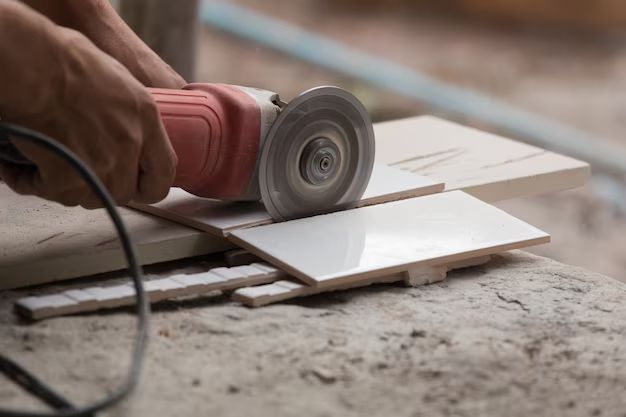Using an angle grinder is one of the most common methods for cutting porcelain tile. With the right blades and proper precautions, you can make clean and accurate cuts through porcelain and other tile materials with an angle grinder.
Page Contents
- 1 Is an Angle Grinder Strong Enough to Cut Porcelain?
- 2 Types of Angle Grinder Blades for Porcelain Tile
- 3 Cutting Tips When Using an Angle Grinder on Porcelain
- 4 Cutting Different Types of Porcelain
- 5 Pros and Cons of Cutting Porcelain Tile with an Angle Grinder
- 6 Alternative Cutting Methods
- 7 Safety Tips When Using an Angle Grinder
- 8 Conclusion
Is an Angle Grinder Strong Enough to Cut Porcelain?
Porcelain tile is an extremely hard and dense material, which makes it more challenging to cut than ceramic tile. However, angle grinders generate enough power and torque for cutting through porcelain. The key is using a diamond tile blade designed for porcelain rather than a blade made for cutting metal or masonry.
A standard 4-1/2” angle grinder that operates between 5000 to 10000 RPM will cut through porcelain tile up to 3/4” thick without too much difficulty. Thicker porcelain tiles may require a more powerful 5” or 7” grinder operating at a minimum of 9000 RPM.
Types of Angle Grinder Blades for Porcelain Tile
There are a few types of angle grinder blades specifically made for cutting porcelain:
- Continuous rim diamond blade – This is the most common and economical type of blade for porcelain tile. It has diamonds continuously around the perimeter of the blade.
- Turbo rim diamond blade – The diamonds are concentrated on the outer rim of the blade, allowing faster cuts.
- Sintered diamond blade – The entire face of the blade contains a sintered diamond abrasive for the fastest cutting of porcelain.
Always check the blade’s RPM rating to ensure it meets or exceeds the RPM of your angle grinder. Using an undersized blade can result in slow cuts or blade breakage.
Cutting Tips When Using an Angle Grinder on Porcelain
Follow these tips to safely make accurate cuts when cutting porcelain tile with an angle grinder:
- Use a wet cutting technique – Continually run water over the blade and tile to minimize dust and overheating.
- Take it slow – Don’t force the blade. Allow it to cut at its own rate to avoid blade breakage.
- Support the tile – Rest the tile on a firm, flat surface close to the ground for stability.
- Follow a guide – Run the edge of the grinder base along a straightedge guide for straight cuts.
- Make shallow passes – For curved cuts, make several shallow passes rather than one deep pass.
- Wear safety gear – Use eye protection, ear protection, gloves, and a dust mask.
Cutting Different Types of Porcelain
There are a few varieties of porcelain tile to be aware of when cutting:
- Regular porcelain – The most common and easiest type to cut. Can be cut with a standard diamond blade.
- Glazed porcelain – Has an extra protective glass layer fused on top. Requires a specialized blade for glazed tiles.
- Polished porcelain – Has an ultra-smooth polished surface. A sintered blade provides the best results.
- Dense porcelain – Extremely hard and dense. Use a turbo or sintered blade along with a high power angle grinder.
Pros and Cons of Cutting Porcelain Tile with an Angle Grinder
Here are some of the key advantages and disadvantages of using an angle grinder for porcelain tile:
| Pros | Cons |
|---|---|
| Makes straight or curved cuts | Messy process – generates a lot of dust and debris |
| Wet cutting capability | Diamond blades wear out over time |
| Portable and accessible | Potential for cracks or chips if not careful |
| Lower cost than tile saw | Not as precise as tile saw for certain cuts |
| Cuts variety of thicknesses | Safety hazards from spinning blade |
Alternative Cutting Methods
While an angle grinder is a very effective tool for cutting porcelain, here are a few other options depending on the type of cuts required:
- Wet tile saw – More precision for straight cuts and beveled edges.
- Jigsaw – Better for detailed curved or irregular cuts.
- Tile nippers – For quick snap cuts and smaller detailed cuts after scoring the porcelain.
- Manual tile cutter – For straight score and snap cuts in typical smaller tile sizes.
Safety Tips When Using an Angle Grinder
Angle grinders must be used with caution to prevent accidents or injuries. Here are some key safety measures:
- Wear eye protection and a face shield – particles can fly off the blade.
- Use thick, cut-resistant gloves – helps protect hands from the spinning blade and sharp tile edges.
- Wear long pants and closed toe shoes – prevents cuts and skin exposure to debris.
- Avoid loose clothing – baggy clothes can get caught in the spinning blade.
- Use a dust mask or respirator – protects lungs from inhaling fine tile dust.
- Keep firm grip – don’t let the grinder jerk or kickback from binding on the tile.
- Unplug when changing blades – prevents accidental startup while hands are near the blade.
Conclusion
Cutting porcelain tile with an angle grinder is an effective method when the proper diamond tile blade and safety precautions are used. The high RPM and torque generated can make clean cuts through porcelain of varying thicknesses. Always work carefully and use the appropriate techniques to minimize cracking, chipping, or shattering of the hard porcelain material.
